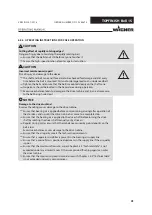
42
VERSION 01/2018
ORDER NUMBER DOC 2385674
TOPFINISH Bell 1S
Notice
A suitable pressure switch for monitoring the bearing air is listed in Chapter 14.13.
Suitable filters for bearing air, drive and stop air are listed in Chapter 14.12.
Warranty claims are void in case of damage due to incorrect handling!
O-rings have to be greased lightly with Vaseline.
In order to avoid back-spraying, ensure that shaping air with min. 0.03 MPa; 0.3
bar; 4.35 psi is applied for approx. 2-3 seconds before opening/after closing all the
product inlets.
Air guidance of the steering air is one of the factors influencing the evenness of the
atomizer pattern. The steering air ring must not be damaged or dirty.
To limit the flushing agent amount with a local flush pressure regulator or a flush
agent throttle is imperative.
Carry out the basic setting using the adjusting part.
Procedure
1. Apply bearing air (BA) at the high-speed rotary atomizer.
2. Preset pressure for bearing air to 0.55 MPa; 5.5 bar; 80 psi.
WAGNER recommends installing a pressure switch, which shuts the high-speed
rotary atomizer down automatically when the pressure falls below 0.54 MPa, 5.4 bar;
78 psi. Spindle rotation without bearing air may cause damage.
The presence of bearing air should be checked by briefly turning the spindles by
hand. If the spindle cannot be turned with ease, the bearing air setting should be
checked again.
3. Set product pressure to 0.1 MPa; 1.0 bar; 14.50 psi.
4. Put the supply system for coating product and flushing agent into operation.
5. Use solvent to check the system for leaks.
6. Flush high-speed rotary atomizer with solvent, flushing through the flushing valve
(FB).
7. Set the speed of the high-speed rotary atomizer via the external control system to
5,000–10,000 rpm and power up the high-speed rotary atomizer slowly.
8. Check whether there are any vibrations on the high-speed rotary atomizer.
9. Set speed to 25,000 rpm using external control system.
10. Set steering airs SA1 and SA2 to 0.03 MPa; 0.3 bar; 4.35 psi to prevent the spray jet
titling to the rear.
11. Open product valve.
12. Check spray jet geometry.
Notice
If the high voltage is not switched on, a turbulent (wobbling) spray pattern may
result. This effect is eliminated by switching on the high voltage.
13. Adjust spray pattern geometry if required by adjusting the pressure (0.05 MPa; 0.5
bar; 7.25 psi – 0.4 MPa; 4.0 bar; 58.02 psi).
If necessary, use a larger or smaller bell plate.
14. Calibrate spray product and solvent (for description, see Chapter
).
15. Switch on and set high voltage (20 – 100 kV).
Notice
If necessary, this optimization should be tested with another product nozzle or another
bell diameter. Verify safe operational conditions.
















































